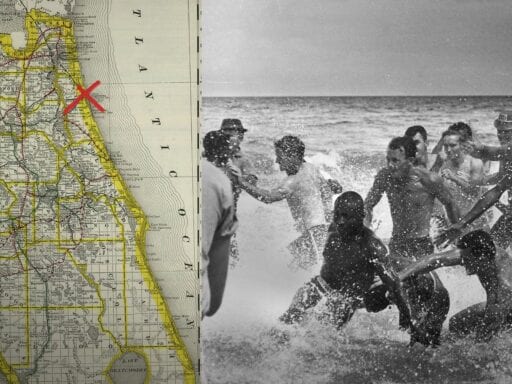The forgotten “wade-ins” that transformed the US.
When we think of the most iconic moments of the US civil rights movement, we might imagine bus boycotts, lunch counter sit-ins, or the March on Washington. Most of us don’t think of protests at beaches and pools. These were the “wade-ins” of the 1950s and ’60s, in which demonstrators demanded equal access by stepping into whites-only waters. And although it’s overlooked by most history textbooks, one summer of protest in the small coastal city of St. Augustine, Florida, played a crucial role in passing the Civil Rights Act of 1964.
This fight was about more than just enjoying a public beach — it was about who gets to control where Black bodies can swim, relax, and simply exist. And it followed a long history of recreational spaces becoming flashpoints of racial conflict.
Watch the video above to see how the St. Augustine wade-ins changed the US forever. And for more of an in-depth narrative from the St. Augustine protesters, you can also hear me tell this story on a special episode of Today, Explained wherever you listen to podcasts.
If you want to learn more about wade-ins, check out the work of Clennon King and AugustineMonica Films’ feature-length documentary and discussion program. For information and great archival sources, take a look at the Accord Freedom Trail and the Civil Rights Library of St. Augustine. And for two books on the movement to desegregate public waters, check out Andrew Kahrl’s The Land Was Ours and Free the Beaches.
This is the seventh installment in Missing Chapter, where we revisit underreported and often overlooked moments of the past to give context to the present. Our first season covers stories of racial injustice, identity, and erasure. If you have an idea for a topic we should investigate in the series, send it via this form!
You can find this video and all of Vox’s videos on YouTube. If you’re interested in supporting our video journalism, you can become a member of the Vox Video Lab on YouTube.
Millions turn to Vox each month to understand what’s happening in the news, from the coronavirus crisis to a racial reckoning to what is, quite possibly, the most consequential presidential election of our lifetimes. Our mission has never been more vital than it is in this moment: to empower you through understanding. But our distinctive brand of explanatory journalism takes resources. Even when the economy and the news advertising market recovers, your support will be a critical part of sustaining our resource-intensive work. If you have already contributed, thank you. If you haven’t, please consider helping everyone make sense of an increasingly chaotic world: Contribute today from as little as $3.
Author: Ranjani Chakraborty
Read More



